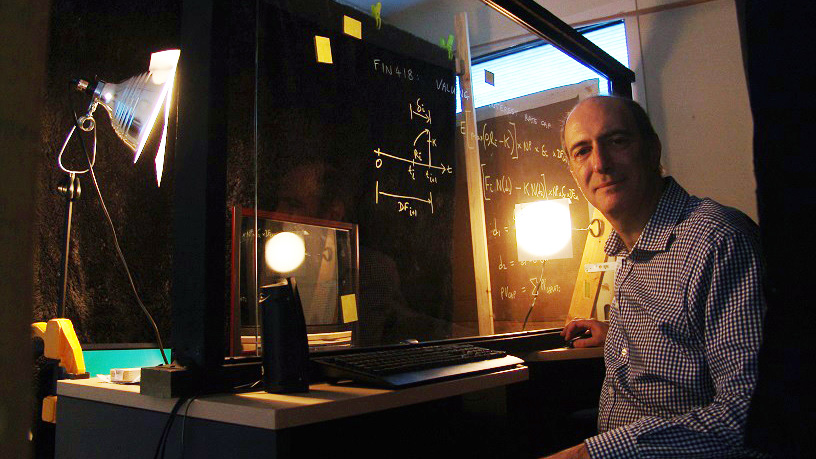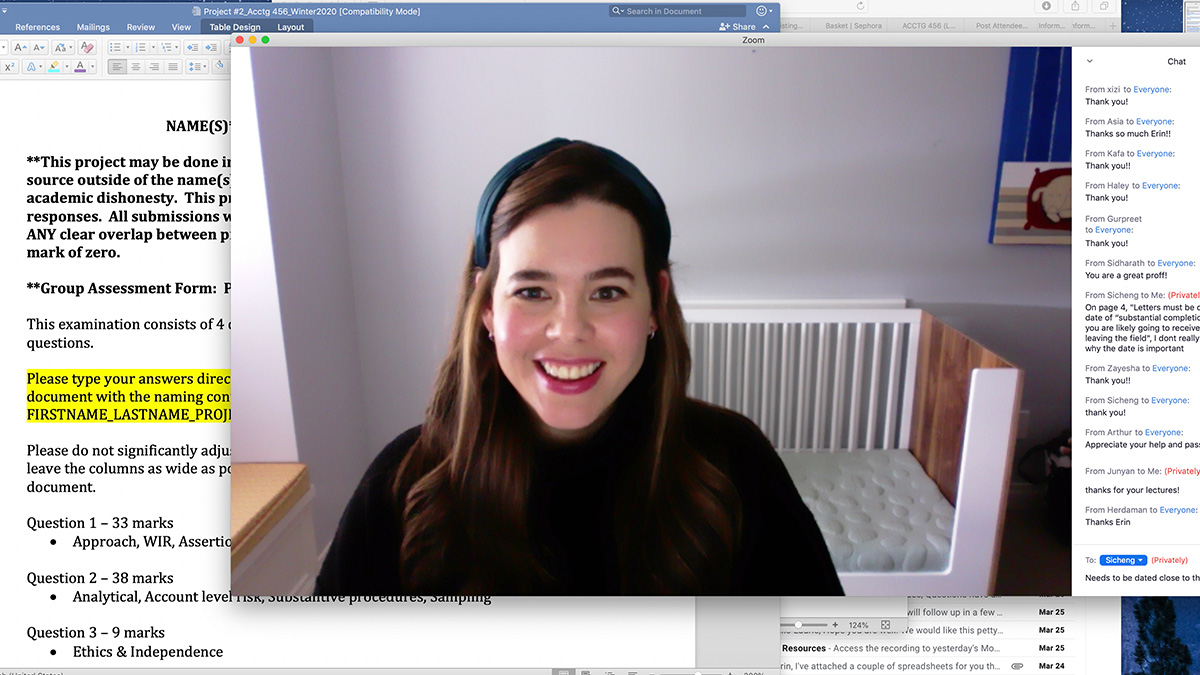In 2019, when the Alberta School of Business developed a strategic plan with a focus on "entrepreneurial thinking", there was no thought that a global pandemic would put that thinking to the test. Fast forward to March 14, 2020, and everything changed. With the increasing global spread of COVID-19, the University of Alberta made the decision to transition all in-person classes and exams to remote delivery - and it all had to be done in three days.
The scale of the transition was enormous: 40,000 students, hundreds of courses, and 89,000 exams to deliver. At the Alberta School of Business, instructors quickly rose to the challenge. In their own words, here are three examples of instructors who successfully adapted to the situation and put entrepreneurial thinking into action.
Keith Godfrey
Lecturer
Department of Finance & Statistical Analysis
FIN 413 - Risk Management
FIN 418 - Fixed Income

Keith Godfrey with his innovative light board set-up
My approach to remote delivery was to build a 'light board' and use it for online classes, online video-conferencing and pre-recordings. The instructor can face the camera while writing, and the students see the instructor through the lightboard. A mirror flips the image so that the students see the writing the same way round as the instructor. It might look like I am writing with my left hand and writing backwards, but actually, I am writing normally with my right hand.
When the news came out on Saturday, March 14 that we were to teach remotely, I went out that afternoon to start buying the components and I built my light board studio by the end of that weekend. Here is an example of the light board in action.
I feel that the light board makes remote teaching much more fun and interactive. While I look forward to a return to face-to-face teaching, I am ready to teach remotely for as long as needed.
Student Feedback
Thank you for a great semester, and thank you for continuing to lecture through remote delivery :)
Thank you for the semester and keeping up with the quality of teaching!
Thank you for the class and the effort you've put in for the transition to online lectures.
Erin Marshall
Executive Professor
Department of Accounting, Operations & Information Systems
ACCTG 456 - Assurance on Financial Information

Erin Marshall with her online ACCTG 456 class
In the Winter Term, I taught two sections of ACCTG 456. This class was already partially blended, so the transition was relatively seamless, but there were several things that helped successfully adapt the course fully:
Maintaining interactive classes through Zoom
ACCTG 456 is a highly interactive course where students often work in groups to complete exercises and cases in class. We were able to continue with this method using breakout rooms in Zoom. Students would work with their peers and I would visit each breakout room to check-in on progress; students could share their screen with me and I could share with them. This of course had challenges, but students kept a positive attitude and kept working hard.
Conducting online assignments actively in Zoom
Assignments in ACCTG 456 are done in real-time in groups. Students can access any material they choose and can also ask each other - and me - questions. During the one remaining assignment, I created a Zoom meeting where I could either put students in groups or they could stay on camera individually and ask questions as needed.
Mandating the use of video for class attendance
I felt like students adjusted very well to the online environment; I was on the fence about mandating video, but all of the students adapted to this no problem and it helped keep the class environment real and more personal. It was also nice to login to the class early and chat with the students who were already there. I think this also helped students work on communication skills and get used to putting themselves out there, building confidence.
Using a final project instead of a final exam
This was always the plan for the course, but I think it really helped reduce student anxiety and allowed them to freely engage with the virtual material. ACCTG 456 is a very open-ended, writing-based class, so there is a lot of flexibility in this type of assessment.
Using video debriefs
Key parts of the class and assignments were debriefed with videos so that students could have permanent access to the main points of the class. This also ensured that students who weren't able to attend the lectures or who had technical issues could catch-up quickly and easily (reviewing a 10-minute video versus re-watching an 80-minute class).
Student Feedback
I found the break out groups on Zoom really helpful especially when we were put in different breakout groups throughout the class. This was useful because we were able to interact with more members of the class and able to hear more opinions and ideas on the material we learned.
I have found this course to exemplify the importance of the use of technology in best preparing individuals and organizations for the rapid and constant adaptations to changing situations that are required in today's world.
Phil Cote
Sorensen Executive Professor of Finance and Risk Management
Department of Finance & Statistical Analysis
FIN 488 - Applied Data Science in Commodities & Finance
The higher education space has been met with many challenges in recent years that are aligned with its core objectives of creating emerging leaders for today's marketplace. More specifically in Finance, today's marketplace requires an ability to master digital tools, or data science skills, to operate at all levels in an organization. Much of the learning content outside universities is already online (for example, Coursera, DataCamp).
I joined the U of A in 2018 and established a strategic vision for my classes in terms of content design and delivery to enhance students' learning experience as well as stay as relevant as possible to the demands of the marketplace. The Finance department has been extremely supportive and the students' reception has been as well.
Class deliveries were designed from the start with online, interactive and reproducible material, which was made available on GitHub, U of A servers as well as strategic alliances with data vendors so that students could work easily in a data science workflow. Examples are available on my website at www.r4tropic.com under the "Posts" section.
Whilst it made the transition easier as it's no different than a face-to-face class, the transition to fully online delivery does require teaching and learning differently; we can only be successful working together. From a teaching standpoint, we adapted, but more importantly it required (i) a heightened awareness to students' progress - this is great to test with online polls and (ii) a commitment to being available for student support.
It is becoming clearer that the implications post COVID-19 may be far ranging and create ever further change:
- Students will have different expectations of us in terms of mode of delivery and support.
- Universities will need to strategically create more blended learning content as part of structured programs.
Student Feedback
I would just like to say thank you again for everything you've done this year. This has been one of the most challenging but informative and engaging classes I've ever taken and I would without a doubt recommend it to anyone who wants to advance their skills in commodities trading and or data analytics.
I just wanted to thank you for the great semester. Although R is definitely not my strong suit, I really enjoyed taking your class. I appreciate the hands-on and practical approach.